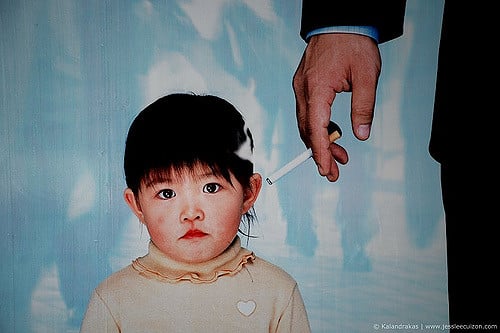
Passive smoking, or secondhand smoke, is a serious health problem causing more than 41,000 deaths annually.
While smoking is known for a multitude of health risks, secondhand smoke is largely overlooked. Not only is it dangerous for adults, but children as well. Secondhand smoke is especially harmful to young children, and it contributes to lower respiratory tract infections, sudden infant death syndrome (SIDS), ear infections, and others.
Could exposure to passive smoking in childhood contribute to arthritis in adulthood? Scientists carried out a study to find the answer to that question, and here is what they found out.
Smoking and arthritis.
The relationship between smoking (any kind) and arthritis is nothing new. Previously, it has been associated with both osteoarthritis and rheumatoid arthritis. For example, a study whose findings were published in the Annals of the Rheumatic Diseases examined 159 men with knee osteoarthritis.
Of these, 19 men were smokers. After adjusting for multiple parameters, scientists discovered that smokers had an increased risk for cartilage loss and they also had higher pain scores. Based on these findings, scientists concluded that smoking aggravates symptoms of osteoarthritis.
A meta-study that appeared in Arthritis Research & Therapy found that compared to people who never smoked, the risk of developing rheumatoid arthritis increased by 26 percent. Scientists who worked on this research concluded that lifelong cigarette smoking was positively linked with the risk of rheumatoid arthritis, even among smokers with a low lifelong exposure.
As demonstrated by these two studies, the link between arthritis and smoking is evident. But, what about the relationship between passive smoking and arthritis?
Passive smoking and arthritis.
Passive smoking is one of many causes of joint pain according to the study whose findings were presented at the Annual European Congress of Rheumatology (EULAR) 2017 press conference. This particular study was carried out by Professor Raphaèle Seror and a team of researchers at the University Hospitals of South Paris. For the purpose of the study, they enrolled a large population of female volunteers who were born between 1925 and 1950. Participants have been followed since 1990.
In total, 70,598 women participated and 1,239 ladies self-reported developing rheumatoid arthritis. About 350 cases were eligible for the analysis of the relationship between secondhand smoke and arthritis. It is also important to mention that the average age of women in the study was 49, while the follow-up was 21.2 years.
From 1990-2014, scientists sent out 11 questionnaires to the participants in order to gather demographic, medical, hormonal, and environmental data, as well as dietary habits. They also analyzed exposure to passive smoking in childhood.
Results showed that exposure to secondhand smoke in childhood intensified the link between rheumatoid arthritis and adult active smoking. Smokers who were exposed to passive smoking in childhood had a 1.73 hazard ratio compared to nonsmokers who weren’t exposed to passive smoking in childhood years.
What do scientists say?
Scientists who worked on this study not only confirmed the link between smoking and rheumatoid arthritis, but they also demonstrated that even exposure to passive smoking can increase one’s odds of developing this common type of arthritis.
To assess secondhand smoke exposure in childhood, the questionnaire featured questions such as, “When you were children, did you stay in a smoky room?” Participants were considered exposed if their answer was “yes, a few hours” or “yes, several hours a day.”
Professor Seror explains that this research highlights the importance of avoiding exposing children to tobacco, especially if there is a history of rheumatoid arthritis in the family.
Another important discovery from this study was that smoking is also associated with an increased progression of structural damage to the spine in patients with ankylosing spondylitis, a type of arthritis that affects the spine.
Arthritis risk factors.
Basically, everyone can develop arthritis muscle pain and experience decreased range of motion and tremendous discomfort, but some people are at a higher risk. Scientific research confirmed that smoking and exposure to passive smoking are major risk factors, but others play a role too. Here are common risk factors that enhance your odds of developing arthritis:
- Age: our risk of arthritis increases significantly as we get older.
- Sex: although arthritis can affect both genders, it is more prevalent among women. Only gout and ankylosing spondylitis are more common in men.
- Weight: we are more likely to develop arthritis if we are overweight or obese due to the pressure on our joints brought on by the excess weight.
- Family history: just like with many other diseases and health conditions, heredity plays a role here as well.
- Previous joint injury: people who have been injured in the past are more likely to develop arthritis in the affected joints.
Conclusion
Exposure to secondhand smoke increases the risk of numerous health conditions, and arthritis is not an exception. The latest study found that being exposed to passive smoking in childhood can increase one’s odds of developing rheumatoid arthritis. The same study also confirmed that active smoking is closely related to arthritis as well. Ditching cigarettes is always the right thing to do, but it is also important to avoid exposing children to cigarette smoke.
~
~
~
Author: Ella James
Image: Flickr/J3SSL33
Editor: Travis May
Copy Editor: Nicole Cameron
Social Editor: Yoli Ramazzina








Read 0 comments and reply